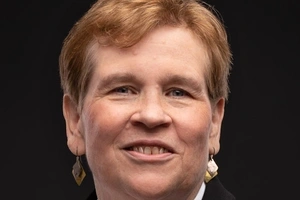Faculty Expert
Why do university faculties often lack racial diversity?
A common explanation is that the pool of minoritized candidates is too small and hard to reach. But according to Penn GSE’s Damani White-Lewis, the root causes run much deeper than that.
An expert on faculty recruitment and retention, White-Lewis has found that faculty hiring decisions too often rely on routines that contribute to inequitable patterns. It’s possible to disrupt these patterns, but leaders and faculty must be willing to examine their biases and rethink “tried and true” recruitment and hiring practices that replicate past inequities. Many universities have incorporated White-Lewis's evidence-based recommendations into their hiring guidelines.
Here, White-Lewis shares 10 tips for achieving a more diverse professoriate.
Before posting the ad: Tips for establishing hiring priorities, recruiting candidates, and forming search committees
Widen your hiring priorities. How an academic unit determines its hiring priorities can shape the potential results of the search before it begins (White-Lewis, 2021). Rather than instinctually replicating previous subfields, ranks, and search criteria, think creatively about how racial equity impacts the formation stages of each search. For example, after the summer of 2020, many institutions began conducting cluster hires related to equity and inclusion as a way to attract and hire more faculty of color. Other methods for widening hiring priorities to increase opportunities for diversity are discussed in White-Lewis (2021).
Differentiate between active and authentic recruitment. Too often the notion of active recruitment neglects the quality of engagement — as in, how well candidates are being recruited throughout the year. Examine the authenticity of your current recruitment strategy by reflecting on the quality and duration of your interactions with those in the field. The frequency with which you email candidates, set up meetings during conferences, and have colloquia to attract candidates is just as important as how authentically you engage with the candidates during these activities.
Pursue postdoctoral pathways. Research suggests that faculty diversity will not meaningfully increase unless we increase the number of racially minoritized postdoctoral scholars who successfully transition into academia (Gibbs et al., 2016). And yet, postdoctoral positions are the least studied and supported aspect of academic careers when compared to graduate education and the professoriate. This has begun to change as research on postdoctoral careers and pathways has increased. Culpepper and colleagues (2021) examined 38 different conversion programs to identify differences and similarities in their policies and practices. They found that programs were largely organized by five stages (sequenced in this order, though leaders are encouraged to experiment within and between stages based on their contexts and needs): (1) laying the foundation; (2) recruiting fellows, matching to a mentor/department, and pre-arrival preparation; (3) fellowship period; (4) conversion to the tenure track; and (5) ongoing, iterative evaluation for program improvement. They and others (e.g., White-Lewis et al., 2022) highlight the importance of thinking systemically when creating and sustaining postdoctoral conversion programs.
Understand and leverage the important role of leadership. How leaders conceive of and pursue progress impacts multiple points of the hiring process, such as determining when a search has enough diversity in the general pool to proceed without delay (White-Lewis, 2022). In a study of administrators and academic leaders, White-Lewis (2022) identified a typology of leaders’ implicit theories of change (Kezar et al., 2015; Reinholz & Andrews, 2020), or perspectives on what it will take to make meaningful progress in hiring faculty of color. Under lax leadership conditions, opportunities for enhanced inclusion can be missed and stalled, whereas more stringent standards — with necessary supports — may yield more consistently positive hiring results.
Increase the diversity of your search committees. A recent study found promising relationships between search committee diversity and applicant pool representation of women and racially minoritized faculty candidates (Kazmi et al., 2021). In an analysis of recruitment data (13,750 job ads), the researchers found that women search committee chairs and higher percentages of women search committee members related to more women applicants, and that more racially minoritized search chairs and higher percentages of racially minoritized search committee members related to higher applicants from that group as well. The study, which used quasi-experimental field methods, also found that women and racially minoritized faculty were also more active in reaching out to more diverse applicants.
Importantly, efforts to increase the diversity of search committees should account for the documented evidence of inordinate service labor placed on minoritized faculty. Leaders can mitigate service imbalances by providing additional supports to compensate and by using modern empirical tools like service dashboards (O’Meara et al., 2020).
Rethinking “fit”: Tips for faculty evaluators when reviewing and ranking candidates
Calibrate preferences before reviewing candidates. When it comes to evaluation criteria like research impact and fundability, evidence indicates that our preferences and tastes are idiosyncratic (White-Lewis, 2020). Often, search committee members assess files in pairs, and use an aggregated cut-off score to determine who makes it to the short list or who is discussed during deliberations (Culpepper et al., 2023). If discrepancies between raters are wide enough, groups of candidates can fall through the cracks, especially if there is not consensus on criteria that reproduce structural inequalities in faculty careers.
To avoid these problems, committees should work toward forming consensus in how criteria are developed and applied. One way of doing so is by calibrating criteria. Search committee members should be deliberate in assessing their current criteria (i.e., don't simply use last year’s criteria) and recognize how those factors (a) reflect their stated and implicit priorities and the inequitable features of academic reward systems and (b) either create or diminish opportunities for advancing institutional equity goals. After developing criteria, apply them to a batch of fictitious candidates or examples from previous searches to see where scores vary or converge. As a committee, discuss and reach an agreement regarding what constitutes minimum expectations and what demonstrates excellence (White-Lewis, 2020), and then develop a plan for keeping each other accountable in deliberations (Liera, 2019).
Identify racialized disparities in applicant review. Research has continually demonstrated institutionalized racism in multiple criteria that are regularly assessed in faculty hiring. For example, there are repeated disparities in grant attainment based on race (Chen et al., 2022; Ginther et al., 2011; Hoppe et al., 2019; Taffe & Gilpin, 2021). Moreover, faculty at elite institutions overwhelmingly come from a resoundingly small number of other elite institutions (Clauset et al., 2015; Hunter Wapman et al., 2022; Lee et al., 2021), which cascades and unevenly impacts candidates’ research productivity (Li et al., 2022; Zhang et al., 2022). Where scholars obtain their terminal degree, the productivity that engenders, and the funding they acquire are critical career aspects of faculty careers with implications that reverberate within and across careers. Therefore, it is important to acknowledge and account for these durable disparities when reviewing candidates to ensure that evaluations are equitable.
Address racialized disparities in applicant review through counterbalancing. Given that committees cannot not evaluate grantsmanship, productivity, and institutional type, it's important to develop ways to address these areas without reproducing the durable disparities associated with them. Two proven methods are balancing within criteria and balancing between criteria. Balancing within criteria means integrating equity parameters within selection criterion, such as the use of culturally relevant pedagogy when evaluating teaching, experience with and quality of mentoring racially minoritized students, and other possibilities as described by Liera and Ching (2019). Balancing between criteria means manipulating the order and weight of criteria such that one factor does not outweigh others. This could mean reducing the emphasis on grantsmanship, or evaluating it after evaluating important diversity, equity, and inclusion (DEI) criteria, as is the case with UCLA’s mentor professor program that has led to the successful hire of multiple excellent faculty of color.
Harness the potential of candidates’ DEI statements. DEI statements have become hotly contested for numerous reasons. The most ardent critics suggest that they are a political litmus test (Rufo et al., 2023), whereas others highlight that they are such a recent advent that they are still poorly understood and evaluated (O’Meara et al., 2020). Regardless of the reason, there is a clear need to better understand optimal practices surrounding diversity statements. White-Lewis and McLewis (2021)* identified multiple dimensions that faculty evaluators use to discern rigorous, high-quality diversity statements from weaker diversity statements. These include inferring how candidates demonstrate (a) leadership and initiative in DEI settings, (b) an authentic commitment to DEI and concrete, rather than abstract, forms of identity, and (c) concrete, tangible evidence of DEI commitments. There is also the opportunity to use DEI statements within the balancing procedures described in the preceding tip, given that such procedures ideally reveal a candidate’s commitment to DEI across research, teaching, and service areas.
Explore emergent selection practices. Emergent selection techniques are being deployed and experimented with across the country. Connect with other campuses to understand what practices are working, within what contexts, and why. Some of these include anonymizing certain aspects of candidate review, like where their publications come from (e.g., Yale University’s Molecular Biophysics and Biochemistry Department), applying holistic review standards from admissions (Bastedo et al., 2018), re-examining candidates even if they fall underneath a threshold (Culpepper et al., 2023), and moving away from a list in which candidates are ranked from first to last toward a threshold list that indicates the suitability of all finalists (White-Lewis et al., in press).**
Damani White-Lewis studies racial inequality in academic careers using methods and theories from organizational behavior and social psychology. He regularly advises organizations on issues related to the academic profession, racial equity, and institutional transformation in higher education. Dr. White-Lewis is an assistant professor of higher education at the University of Pennsylvania Graduate School of Education.
* White-Lewis, D., & McLewis, C. (2021). Deeper than the pool: The merit of mentoring in advancing faculty diversity. Paper presented at the annual meeting of the Association for the Study of Higher Education, San Juan, PR.
** White-Lewis, D., O’Meara, K., Wessel, J., Anderson, J., Culpepper, D., & Templeton, J. (in press). Making the band: Constructing competitiveness in faculty hiring decisions. Inside Higher Education.
Media Inquiries
Penn GSE Communications is here to help reporters connect with the education experts they need.








